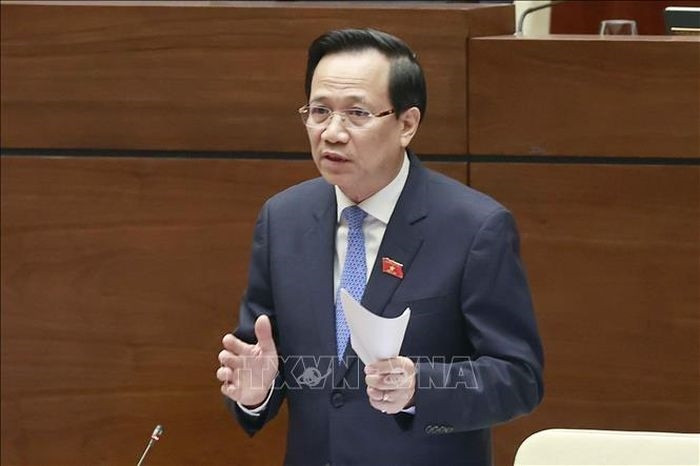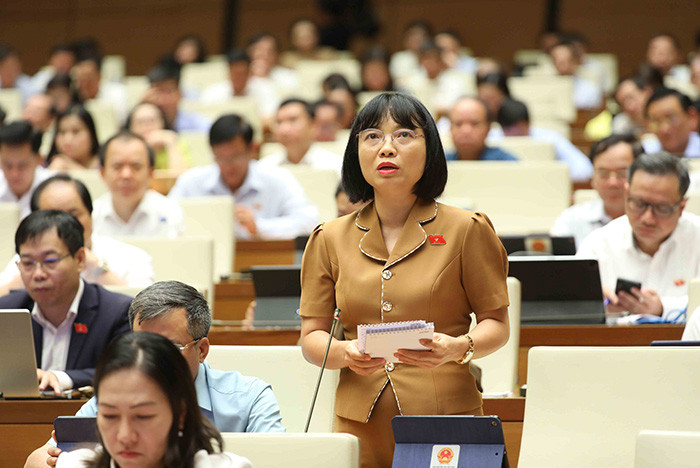Inadequacies in the implementation of vocational education are one of the issues that National Assembly deputies are concerned about.

Minister of Labor, War Invalids and Social Affairs Dao Ngoc Dung answers questions
On the morning of June 6, continuing the 5th session, the 15th National Assembly conducted questioning on the first group of issues in the field of labor, war invalids and social affairs.
Minister of Labor, War Invalids and Social Affairs Dao Ngoc Dung admitted that there are still many shortcomings in planning the training network. In the coming time, the Ministry will be more drastic in forecasting supply and demand so that vocational training is truly linked to market needs.
Build parent and student support
Questioning at the meeting, delegate Huynh Thi Anh Suong (Quang Ngai) asked the Minister of Labor, War Invalids and Social Affairs to clarify the solutions, policies and implementation time to attract good and excellent students to vocational education. "When will vocational education be a level of education in the national education system, chosen by students, and not the last choice when they fail to pass the 10th grade entrance exam or university entrance exam?", the delegate frankly said.
Responding to this issue, Minister of Labor, War Invalids and Social Affairs Dao Ngoc Dung said that vocational education is a level in the national education system. The Government has completed the entire structure and system of vocational education; there is connectivity between general education, vocational education and university education.
The National Assembly has passed three laws related to this field, including the Law on Higher Education, the Law on Education, and the Law on Vocational Training. Currently, the current enrollment scale is about 2 million students entering vocational training. Compared to 5 years ago, the average number of students per year was only about 500,000, "showing clear progress" - the Minister said. "Currently, the scale and quality of vocational education still need a lot of attention. The scale is not large. The quality of vocational education still needs to be innovated and improved. The system of legal policies, policies to provide incentives, encouragement, and create conditions for students to enter vocational schools is not much", the Minister frankly acknowledged.
To innovate vocational education, Minister Dao Ngoc Dung said that it is necessary to promote propaganda and change awareness in society. The State has many incentive policies for students in ethnic minority areas to study vocational training completely free of charge; vocational training gives priority to finding jobs; advanced students receive free high-quality training; solutions to connect businesses to create jobs right after graduation (about 85%)...
Regarding solutions to attract vocational students, the Minister emphasized: "The most important thing is to create support from parents and the students themselves so that they can graduate with a job, have a stable income, and have a relatively good life; after graduation, they have the need and ability to continue their studies. The Ministry of Labor, War Invalids and Social Affairs will design policies for vocational students in this direction."

National Assembly delegate of Hai Duong province Nguyen Thi Viet Nga asked questions
However, according to delegate Nguyen Thi Viet Nga (Hai Duong), the report of the Ministry of Labor, War Invalids and Social Affairs said that most colleges and intermediate schools in the vocational education system recruit and train students who have graduated from junior high school. However, in reality, many of these students, because they cannot pass the entrance exam to public high schools, choose to study at intermediate schools with the purpose of obtaining a high school diploma and then continue to take the entrance exam to universities. Believing that "there is a huge waste in vocational intermediate training", delegate Nguyen Thi Viet Nga asked the Ministry of Labor, War Invalids and Social Affairs to provide solutions to overcome this in the near future.
Minister Dao Ngoc Dung said that attracting students to vocational schools is not easy. Recently, the number of students studying at vocational secondary schools has increased due to the application of the principle: After graduating from junior high school, students go straight to vocational schools to study both general education and vocational training, and upon graduation, they will have a vocational certificate and graduate from high school according to the standards and regulations of the Ministry of Education and Training.
"Regarding whether there is waste or not, we think there is no waste," Minister Dao Ngoc Dung affirmed.
According to the Minister, if after graduating from high school, then entering vocational training will take 3 more years. Studying vocational training and studying culture at the same time helps shorten the time, students adapt faster and more conveniently when graduating, can immediately participate in the labor market. Directive No. 21-CT/TW dated May 4, 2023 of the Secretariat on continuing to innovate, develop and improve the quality of vocational education until 2030, with a vision to 2045 (Directive 21) has concluded this issue. Developed countries such as Germany, Japan, Canada... also apply this model.
Based on listening to delegates' opinions, the Ministry of Labor, War Invalids and Social Affairs will evaluate the effectiveness and make appropriate adjustments.
Training network planning still has many shortcomings.
Believing that recently, the number of people choosing to learn a trade has tended to increase but the number of workers receiving vocational training has not met the demand, delegate Tran Thi Thanh Huong (An Giang) stated that although the network of vocational training facilities has been initially reviewed and arranged, there are still many shortcomings and if this situation is not corrected, it will be a waste.
“What should the labor sector do to further improve the effectiveness of student streaming and proactively forecast vocational training needs by field and level, as a basis for developing enrollment plans in line with current labor shift trends? In addition, how will the irrationalities in overlapping, dispersion, and duplication in training occupations be corrected to help vocational education work more closely link with the labor market and human resource needs of each industry and each locality in the coming time?”, delegate Tran Thi Thanh Huong asked.
Similarly, delegate Trinh Minh Binh (Vinh Long) asked Minister Dao Ngoc Dung to explain the reasons why the planning of the vocational education network is not yet linked to the planning of human resource development, the planning and development plans of the industry with the locality as well as solutions in the coming time?
Minister Dao Ngoc Dung said that more than a month ago, the Party Committee of the Ministry reported to the Secretariat on the summary of 10 years of the Law on Vocational Education. The Secretariat issued Directive No. 21 mentioning the scale and quality of vocational education training. "In addition to the progress, the planning of the training network still has many shortcomings. Currently, in the same area, there are many different vocational schools training in many different occupations, overlapping, leading to the number of students not meeting the requirements, having difficulty finding jobs after completing training," said the Minister.
In the coming time, to truly link vocational training to market demand, the Minister affirmed that we must be more aggressive in forecasting supply and demand, and only train when demand is identified. In addition, schools need to link, cooperate closely, and place orders with businesses so that graduates can find jobs.
Considering that there is currently a situation of overlap and duplication in training professions, Minister Dao Ngoc Dung said that vocational schools are basically implementing the spirit of: "training is autonomous, except for some high-quality training professions, which are ordered by the state and trained according to requirements". The general situation of vocational schools is that they can recruit students and then train, not really linked to market needs.
In recent times, 63 provinces and cities have worked with the Ministry to re-plan the vocational education network; organize the merger of secondary schools and vocational education centers according to the principles of "3 in 1", "2 in 1"; a college in a locality can teach many different systems and programs in accordance with the spirit of Resolution No. 19-NQ/TW on continuing to innovate the organization and management system, improving the quality and efficiency of public service units.
Along with that, the vocational school system of ministries, branches and organizations is rearranged in the spirit of uniting under one focal point, in accordance with the Vocational Education Strategy to 2030 with a vision to 2045, to avoid duplication in functions and training professions as at present.
According to VNA